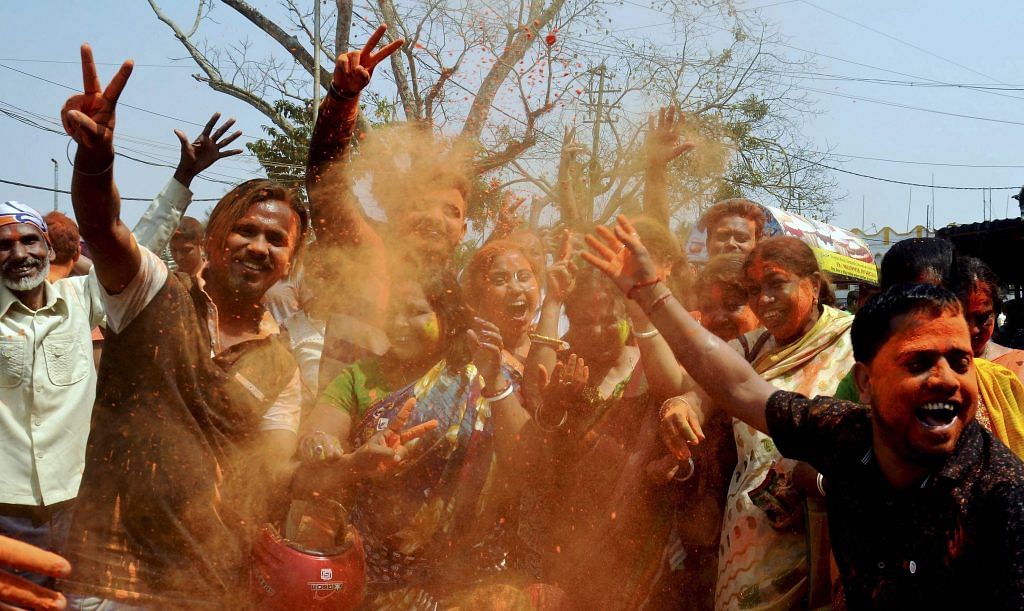The BJP as a political party in India today is what the Left in Bengal and Tripura were, a party without an opposition, capturing all spaces, all leaders, all issues.
If the BJP is the victor today, whatever happened to all the talk of the Modi government’s sliding political narrative? And all that talk about the message from rural Gujarat and Rajasthan, the farm crisis, rural distress, unemployment and Nirav Modi’s escape after swindling thousands of crores?
The answer lies in the BJP’s election machinery that fights elections like a guerrilla army, making itself appear the only choice before voters.
The BJP as a political party in India today is what the Left in Bengal and Tripura were, a party without an opposition, capturing all spaces, all narratives, all leaders, all issues.
The rise and fall of the Left in Tripura is instructive.
Wanting to win, not waiting
In 1993, Prime Minister Narasimha Rao imposed President’s rule in Tripura, sacrificing a Congress government there to gain the support of the Left parties at the Centre. Rao needed to do this to save his own minority government.
Later that year, the Left came to power in Tripura. After that, the Left won five consecutive elections in Tripura because the Congress never tried to win the state. Tripura, for 25 years, has been a one-party state with hardly an opposition.
The BJP’s slogan in Tripura was “Chalo Paltai”, a clarion call to overthrow the Left. The Congress as an opposition party doesn’t seek to paltai. It lingers on so that it automatically gets power when people get fed up with the incumbent, or gets replaced by a smarter opposition – the BJP in Tripura, for instance.
The BJP is sweeping Tripura today by being an opposition party that wants to win. It occupied the entire anti-incumbency spectrum, bringing under its umbrella Bengalis with tribals, RSS workers with Congress cadres, even gobbling up the Trinamool Congress’ significant presence overnight. It matched the CPM’s cadres with its panna pramukhs – one man to persuade 60 voters each.
The BJP didn’t stand a chance in Nagaland and Meghalaya. In Nagaland, it smartly backed a popular rebel from its own ally. In Meghalaya, unpopular with an apprehensive Christian majority, the BJP smartly stayed on the sidelines and now hopes to form the government with clever coalition-making – even though the Congress is likely emerging as the single largest party.
The NaMo question
Does any of that mean the Modi government is not facing discontent from farmers? Or that unemployment is not a big issue across India? Or that Nirav Modi’s and Mehul Choksi’s bank frauds and easy escapes don’t make the Modi government look negligent on crony capitalism?
How much of the BJP’s Tripura victory is because of Modi’s popularity, and how much because it stole away the entire leadership and cadres of the Congress and the Trinamool? What was it that made the difference – the promise of development or an unlikely alliance with a tribal party that wants a separate state?
Soon after the Modi government brought about an end to the Haj subsidy for Muslims, the BJP promised free Jerusalem trips to senior citizens in Nagaland. So, is it Swachh Bharat or dreams of the holy land that made Nagaland vote for BJP ally Neiphiu Rio?
This was a moot point in Gujarat too. After 27 years of ruling the state, BJP had anti-incumbency worth many elections piled up against it. There were three social movements, the Modi factor was missing, and people were unhappy with GST and MSP. In such a scenario, if the BJP was the opposition, there’s no way the incumbent could have won another term. Yet it did, because the incumbent was the BJP.
Where Right met Left
In West Bengal and Tripura, the Left parties kept winning election after election thanks to their famed cadres, their complete mastery over the election system, co-option of local elites, state institutions and civil society alike. It’s not as if there was Ram Rajya and no anti-incumbency all these years in these states.
The BJP’s election machinery will make us reminiscent of the Left rule in Bengal and Tripura. The party has a Left-like single-minded focus on winning elections. This juggernaut is able to ride anti-incumbency again and again – unless its opponent has that same grit to win, such as Arvind Kejriwal in Delhi or Nitish Kumar in Bihar in 2015.
This is why the BJP could also win Karnataka despite Siddaramaiah’s best efforts, and this is why it could win 2019 without delivering Achhe Din.
Shivam Vij is a political commentator based in New Delhi.
